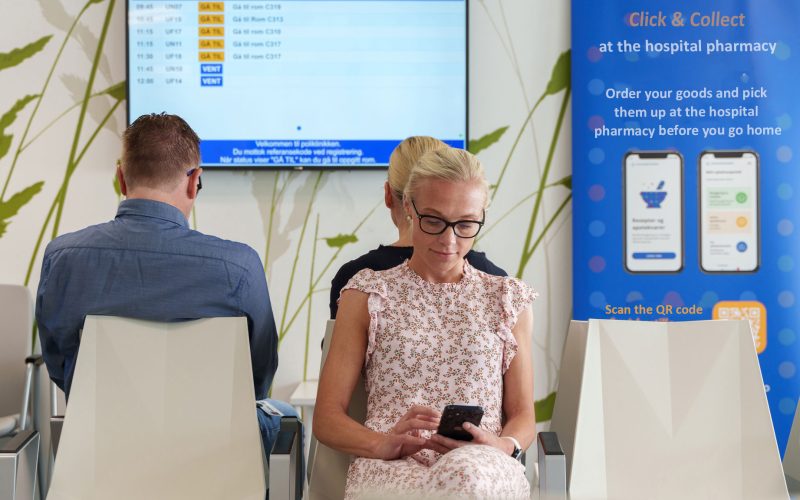Smoother patient flow with digital check-in and queue management
The challenge
Hospitals and outpatient clinics often face unnecessary bottlenecks and stress at the very start of a patient’s journey. Long queues at reception, unclear processes, and manual paperwork can create confusion for patients and slow down operations for staff. Patients arriving early or late disrupt schedules, while staff spend valuable time answering basic questions or chasing missing information.
Without a real-time overview of arrivals, waiting times, or service capacity, it becomes harder to manage flow efficiently, especially when delays ripple across departments.
In many cases, outdated check-in processes contribute to a poor first impression, increased waiting room congestion, and administrative strain, ultimately impacting both patient experience and staff effectiveness.
The approach
Hospitals are now adopting digital check-in and queue management tools that streamline the arrival experience, from the moment the patient walks in, to when they pay and leave.
With easy-to-use kiosks and mobile check-in, patients can register themselves upon arrival. The system confirms their appointment, collects relevant data, and places them in a virtual queue. Staff get real-time visibility on arrivals, no-shows and flow — while patients get a calm, clear, and predictable experience.
Related case studies
No-show rate
cut by 34%
with digital appointment reminders and self-check-in at South–Eastern Norway Regional Health Authority >
Cost savings estimated to
€8.5 million
by smoother patient flow with digital check-in and queue management at South–Eastern Norway Regional Health Authority >
Annual time savings equivalent to
6 full-time positions
enabled by digital self-services. Read the full Menon Economics ‘Benefit analysis of check-in and payment solution by DNV Imatis’ report >
How it works in practice
Self-service check-in
Patients can check in at a kiosk or using their phone. The system verifies their identity, confirms the appointment, and registers their arrival — reducing waiting time at the counter.
Digital queuing
Patients are added to a virtual queue and called in order when ready. Display screens and notifications guide them to the right location — minimising confusion and ensuring better flow through the department.
Payment made simple
After the appointment, patients can pay directly at the kiosk or digitally. There’s no need to return to reception or wait in a separate line.
Real-time updates for staff
Staff can monitor arrivals, delays, cancellations, and queue status across departments, helping them adjust resources accordingly.
Support for drop-in patients
Units that allow walk-ins or unscheduled visits can set up structured drop-in flows with automatic queuing, estimated waiting times, and capacity control.
Related customer news
Self-service check-in at the Pulmonology Outpatient Clinic in Bergen >
Simplifying the patient experience at Østfold Hospital Trust >
Self-check-in and payment solutions introduced at Högsbo Hospital >
Self-check-in and payment at Drammen Eye Outpatient Clinic >
Results seen in practice
Hospitals using this approach have reported:
Reduced “no-shows” by 34%, saving 55 000 appointments
Reduced reception desk workload by 60%, freeing staff for other tasks
Shorter queues and waiting times
Better visibility of patient flow across departments
Increased on-time start for appointments and tests
Higher patient satisfaction

Time savings benefit
A benefit analysis conducted by Menon has highlighted several efficiency gains from implementing DNV Imatis’ check-in, queue management and payment solution. All healthcare providers interviewed reported notable time savings, primarily due to the automation of the processes. The time freed up is now being used for other administrative tasks and/or more patient-facing activities – contributing to improved service quality.
Exaples of reported time savings
Nordland Hospital Trust has saved the equivalent of 6 full-time positions annually through digital check-in and payment.
Diakonhjemmet Hospital reports annual savings equivalent to 1.4 full-time positions.
Bergen Hospital Trust: The laboratory at the Women’s Clinic saves the equivalent of a 50% position each year.

Why it matters
A well-run front door sets the tone for everything that follows. By digitising check-in, payment and queuing, hospitals can eliminate unnecessary delays, improve staff efficiency, and give patients a smoother, more predictable start to their visit.
Want to learn how to improve patient arrival and flow services?
Curious how digital check-in and queue management can reduce waiting times and improve patient satisfaction? From self-service kiosks to real-time flow visibility, our tools help hospitals run smoother from the moment a patient walks in.
Let’s explore what this could look like for your facility.


